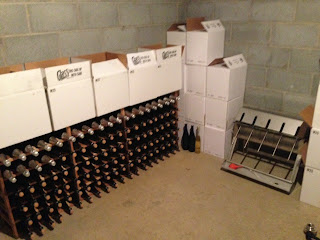Primary Fermentation Complete and First Racking Of 2013 Riesling
I racked the FlexTank and WinePod this past Sunday. Since the WinePod is used only for primary fermentation, I transferred the wine to four 5-gallon carboys. The FlexTank is capable of handling secondary fermentation, so I transferred that wine to a clean FlexTank. After 22 days, the Brix measured 0 degrees (SG = 1.0) in the FlexTank and 5.5 degrees (SG 1.022) in the WinePod. The WinePod sugar sensor was out of calibration, and showed a reading of 3 degrees Brix. I'm not sure what caused the error, whether it be from the accumulation of yeast at the bottom of the tank or just a faulty sensor. No matter how it is measured, the wine fermented slower in the WinePod than the FlexTank. It will be interesting to see whether this results in any differences in the final product. I assume the wine that was in the WinePod will continue to dry down (maybe to zero) now that it is tra...
.JPG)
.JPG)



